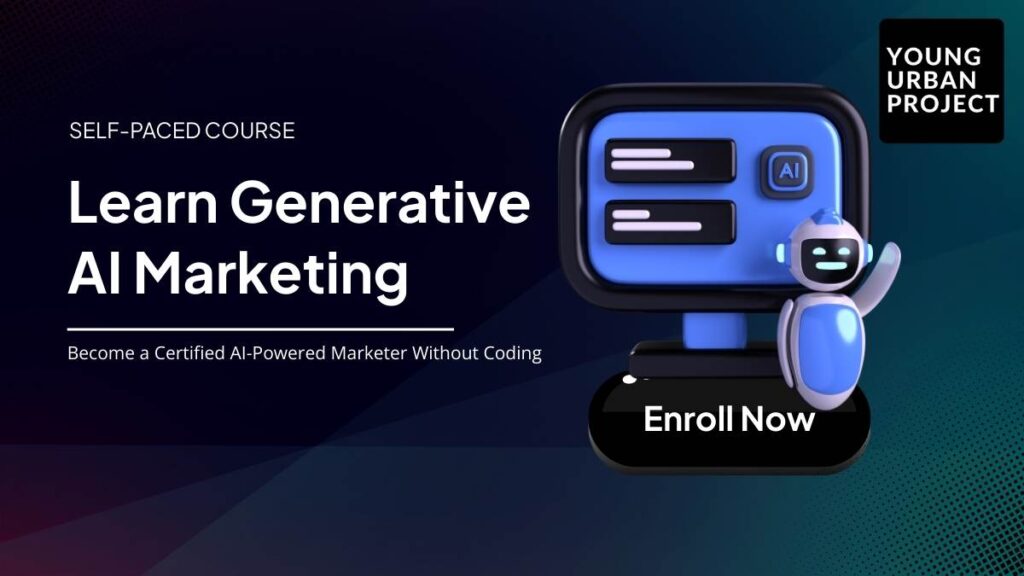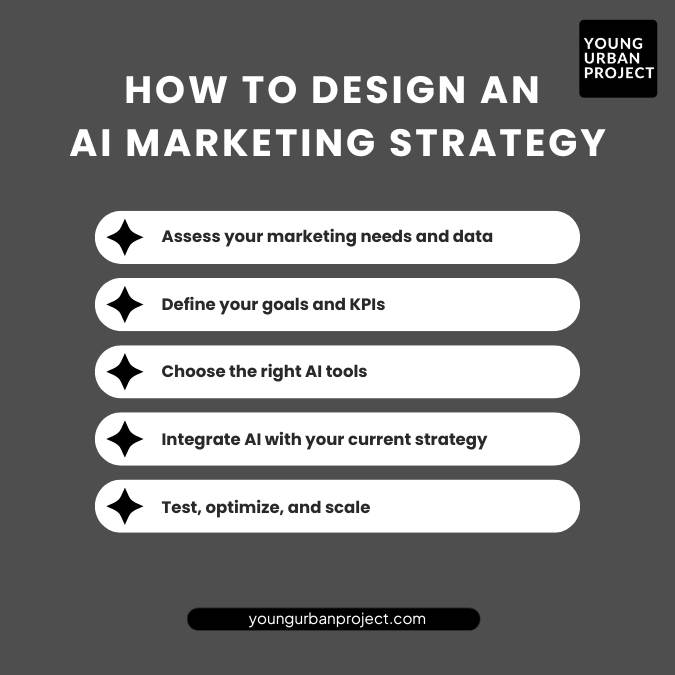AI Marketing is a simple idea, it means using artificial intelligence to improve how businesses do marketing.
Table of Contents
It could be anything from a smart tool that helps write your emails… to an algorithm that shows the right ad to the right person at the right time.
And honestly? It’s changing the entire game in digital marketing.
Why It’s Changing Everything
Before AI, marketers had to manually analyze data, guess what content might work, and test campaigns slowly.
Now, AI can:
- Read huge chunks of data in seconds
- Help personalize ads for each person
- Automate repetitive tasks like email or chatbot replies
It saves time, boosts results, and helps brands connect with people in a smarter way.
Wait… is “AI Marketing” Different From “AI in Marketing”?
Yes, slightly.
- AI Marketing = Using AI as a strategy in your marketing.
- AI in Marketing = Using AI tools inside your marketing work.
Think of AI Marketing as the big picture.
And AI in marketing is the tools that make that picture come to life.
Understanding AI Marketing
What is Artificial Intelligence in marketing?
Artificial Intelligence (AI) means machines that can learn, think, and make decisions, kind of like humans do, but faster.
In marketing, AI is used to:
- Understand customer behavior
- Personalize messages
- Predict what someone might do next
- Automate things like email or ad delivery
So instead of guessing what will work, marketers can use data to know what will likely work.
How AI fits into the marketing process
Let’s say you run an online store. You could use AI to:
- Track user behavior on your website
- Analyze that behavior to find trends
- Predict what products a customer might buy
- Send them a personalized email or show a matching ad
This whole journey, from data to action, can happen automatically using AI.
The key parts of AI in marketing
There are four big pieces that work together:
- Machine Learning: The engine behind AI. It learns patterns in your data.
- NLP (Natural Language Processing): Helps AI understand and write human language.
- Automation: Let AI take actions without manual work (like sending an email).
- Generative AI: Can create stuff, like blog posts, videos, product descriptions, even ads.
These technologies work together to make marketing faster, smarter, and more personal.
Also Read: Types of Generative AI Models
How AI Marketing Works
Let’s break it down simply.
Step 1: Input (Data goes in)
AI needs information to do its job. This could be:
- Website clicks
- Email open rates
- Purchase history
- Social media engagement
- Customer feedback
More data = better results (as long as it’s clean and useful).
Step 2: Processing (AI learns)
AI tools will scan all that data to find patterns. For example:
- Who is most likely to buy this product?
- When do most people open their emails?
- What kind of ads do people click?
It’s like having a super-fast marketing assistant that never sleeps.
Step 3: Output (AI takes action)
Once AI has learned, it can:
- Show the right ad to the right person
- Send a personalized message
- Recommend a product
- Create content
- Or even decide when to post on social media
This can all happen without you lifting a finger.
Common AI Tools in Marketing
Marketers today use AI-powered marketing tools like:
- ChatGPT for content
- Grammarly for writing help
- HubSpot or Salesforce for automation and customer insights
- Canva AI for design suggestions
- Mailchimp for smart email campaigns
More on tools later, but just know, AI is everywhere now.
Also Read: Planning in Artificial Intelligence
Key Use Cases of AI Marketing
Here’s how businesses are using AI in real life:
1. Predictive Analytics
This is about guessing the future, based on real data.
Example: If 80% of people who add a certain product to their cart usually buy it within 24 hours… AI can remind others who did the same thing, maybe with a discount.
It helps brands target the right people at the right time.
2. Real-Time Personalization
AI can change what a customer sees, while they’re browsing.
Think of Netflix or Amazon. Each person sees different suggestions, because AI knows their taste.
Marketers can do the same with:
- Emails
- Product recommendations
- Landing pages
- Ads
No more “one-size-fits-all” messages.
3. Generating Content at Scale
AI tools like Jasper, Copy.ai, or ChatGPT can write:
- Blog posts
- Product descriptions
- Video scripts
- Instagram captions
Fast and often surprisingly well.
Some brands even use AI to generate thousands of ad variations, so they can test what works without writing each one manually.
4. AI Chatbots & Customer Support
Chatbots like Drift, Intercom, or even WhatsApp AI bots can handle:
- Basic customer questions
- Order tracking
- Appointment booking
- 24/7 support
They free up your human team for more complex issues, while keeping customers happy.
5. Email & Marketing Automation
AI helps figure out:
- Who should get an email
- What it should say
- When it should be sent
Tools like ActiveCampaign or Mailchimp do this really well, often leading to more opens, clicks, and sales.
Also Read: Top AI Email Writers
6. AI in Content Marketing & Campaign Management
From planning your content calendar…
To suggesting blog topics…
To measuring campaign success…
AI helps content marketers be more organized, strategic, and data-driven.
Also Read: What is Content Marketing in Digital Marketing?
7. Campaign Performance Optimization
Imagine launching an ad campaign…
Then AI notices that people in one city aren’t engaging, but another city is converting like crazy.
It can adjust the campaign in real-time, maybe increasing budget in the high-performing area, or changing creative where needed.
Smart stuff, right?
Also Read: How to Calculate the Budget of your Google Ads Campaign
Benefits of Using AI in Marketing
Okay, so why is everyone talking about AI marketing?
Here’s what it actually helps with:
1. Higher ROI
AI reduces waste. It shows your message to people who actually care, meaning more leads, more sales, and better return on your budget.
2. Better Customer Experience
Personalized recommendations. Faster support. Helpful content.
All these little things add up to a smoother experience for the customer.
3. Real-Time Decision Making
Instead of waiting days or weeks to analyze results, AI can adjust things as they happen.
That means less guessing, more doing.
4. Better Tracking & Attribution
AI helps track which parts of your marketing are working best.
For example: Did the blog post drive more sales? Or the Instagram reel?
It can connect the dots so you can invest in what works.
Also Read: Types of Artificial Intelligence Systems
5. Smarter Use of Time & Team
Let AI handle the repetitive stuff, so your team can focus on strategy and creativity.
It’s like adding a few smart interns to your team (that work 24/7).
6. Hyper-Personalization
Each person can get a custom experience, based on what they like, click, or need.
This works across:
- Ads
- Emails
- Landing pages
- Even product pricing (in some industries)
7. Higher Conversions
Because people are seeing the right message, at the right time, in the right way…
More of them say “yes.”

Enroll Now: Generative AI for Marketing
AI Marketing Tools & Platforms
There are a lot of AI tools out there.
Some help you write content. Some help you send emails. Some help you understand your audience better.
Let’s break them down into simple categories.
1. Generative AI Tools
These tools can create content, like blog posts, product descriptions, or even images and videos.
- ChatGPT: Helps you write ideas, social posts, emails, or even whole articles.
- Jasper AI: Great for marketers and writers. It gives templates for ads, blogs, and landing pages.
- Copy.ai: Helps create product copy, sales emails, and social media captions.
These tools don’t replace human creativity. But they can speed it up a lot.
2. Predictive Analytics Tools
These tools study your data and help predict what your customers might do.
- HubSpot: A CRM with AI-powered insights and smart automation.
- Salesforce Einstein: Part of Salesforce. It helps you spot trends, score leads, and more.
- PaveAI: Turns Google Analytics data into plain-language reports and suggestions.
Basically, these tools tell you where to focus, and what’s likely to work.
3. Automation Tools
These tools save time by doing repeat tasks for you, like sending emails, scoring leads, or following up with visitors.
- Mailchimp: Sends smart emails based on customer behavior.
- ActiveCampaign: Handles email, automation, CRM, and even SMS.
- Zapier: Connects your tools together. For example, when someone fills a form, it can auto-add them to your email list.
Also Read: LLM vs Generative AI
How to Choose the Right AI Tool
Here’s a simple way to think about it:
1. What’s your main goal?
Need content? Try ChatGPT.
Want to save time? Try automation.
2. What tools are you already using?
Some AI tools work better when connected to your CRM or website.
3. Do you have good data?
Some tools need clean customer data to be effective.
Start small. Test one or two tools. Then build from there.
Designing an AI Marketing Strategy
Jumping into AI tools without a clear plan is like driving without a map. You might get somewhere, but you’ll waste a lot of time (and probably get lost). Here’s a simple way to build an AI marketing strategy that works.

1. Assess your marketing needs and data
Before anything else, ask yourself:
- What do I want AI to help me with?
- Am I trying to save time, get better results, or understand my audience better?
- Do I have good customer data to work with?
AI needs data. If your data is old, messy, or missing, clean that up first.
2. Define your goals and KPIs
Without clear goals, AI can’t really help you. So decide:
- Do you want more leads?
- Better ad performance?
- More engagement on emails or social posts?
Also set simple marketing KPIs, things like click-through rates, conversion rates, or time saved.
3. Choose the right AI tools
Don’t try to use every tool out there. Start with one or two that solve a real problem.
- For content: ChatGPT, Jasper, Copy.ai
- For automation: Mailchimp, ActiveCampaign
- For analytics: HubSpot, Salesforce, PaveAI
Choose based on what you need most, not what’s trending.
4. Integrate AI with your current strategy
You don’t need to throw away your current marketing plan. Add AI where it makes sense.
Examples:
- Use AI to write first drafts of blog posts
- Automate follow-up emails after someone downloads your lead magnet
- Analyze campaign performance using AI dashboards
It’s about making your current efforts smarter, not starting over.
5. Test, optimize, and scale
AI works best when you treat it like an ongoing experiment.
- Try a tool → See the result
- Make changes → Test again
- If it works → Do more of it
This cycle never really ends, and that’s a good thing.
Also Read: How to Use AI in Digital Marketing
Challenges & Pitfalls of AI Marketing
AI can be amazing, but it’s not all smooth sailing. There are a few things you’ll want to watch out for.
1. Data quality issues
AI only works when it has clean and useful data. If your email list is full of fake addresses or your customer info is outdated, AI will make wrong decisions.
Before using any tool, fix your data.
2. Bias in AI models
AI learns from old data, and that data might be biased. If your past campaigns only targeted certain groups, the AI may keep repeating that pattern.
So you need to:
- Watch for unfair targeting
- Make sure your content is inclusive
- Regularly check what the AI is “learning”
3. Over-reliance on automation
It’s tempting to let AI do everything. But if you go too far, your brand can start to feel cold and robotic.
Balance is key:
- Use AI for speed
- Use humans for empathy and creativity
4. Interpreting AI outputs
AI often gives suggestions or results without explaining why. That can be confusing, especially for small teams.
If the AI says “boost this ad” or “target this segment,” make sure you understand the logic before taking action.
5. Risks with AI-generated content
- It can sound generic
- It might get flagged by Google if overused
- It may not match your brand tone
Always edit AI content. Don’t just copy-paste and publish.
Also Read: What is an LLM and how does it work?
Ethical & Privacy Considerations
AI marketing isn’t just about getting results. You also have to respect your audience and their data.
Respect data privacy laws
Laws like GDPR, CCPA, and others are serious about data privacy.
Always:
- Get permission to collect data
- Let people opt out easily
- Be clear about how you use their info
If you break the rules, it’s not just bad for trust, you could get fined.
Be transparent about AI use
If a chatbot is powered by AI, say so.
If a piece of content was AI-generated, mention it somewhere.
It doesn’t have to be a big announcement, just don’t hide it. People appreciate honesty.
Use AI ethically
Don’t use AI to:
- Manipulate people
- Spam inboxes
- Target vulnerable users unfairly
Your AI strategy should help people, not trick them. Brands that focus on trust and transparency always win in the long run.
Also Read: What is MCP in AI?
Future of AI Marketing
AI is still new in the marketing world. But it’s growing fast, and it’s going to change even more in the next few years.
Here’s what’s coming.
1. Personalization at a whole new level
AI will soon be able to:
- Show custom landing pages to every visitor
- Change website content in real-time based on user behavior
- Suggest products, blogs, or offers based on what someone just looked at
It’ll feel like every customer gets their own private version of your brand.
2. Generative video and voice content
Tools like Sora (by OpenAI) and Runway can already create videos from text.
Soon, marketers will be able to:
- Create full video ads using AI
- Clone brand voice for voiceovers
- Build visual content without hiring a production team
This will save time, money, and open creative doors for smaller teams.
3. Smarter, self-improving campaigns
We’ll start seeing AI campaigns that:
- Launch
- Learn from results
- Improve themselves, without human help
It sounds futuristic, but it’s closer than you think.
4. Marketers will need new skills
AI won’t replace marketers. But it will change what marketers do.
You’ll need to:
- Understand how AI works (at least a little)
- Learn to give better prompts
- Know how to edit AI outputs
- Stay curious about new tools
The goal isn’t to beat the AI, it’s to work with it.
Conclusion
AI Marketing is no longer just a buzzword. It’s something real businesses are using right now, to save time, create better content, reach the right people, and grow faster.
But it’s not a shortcut. You still need strategy. You still need human ideas. And you still need to test, learn, and adjust as you go.
If you’re a marketer or a business owner, now’s the time to start exploring AI. You don’t have to master everything overnight. Just try one tool. Use it for one task. See what happens.
That’s how real results start, small, smart steps.
FAQs: What is AI Marketing
1. What is AI Marketing and how does it work?
AI Marketing is when brands use smart tools to help with tasks like creating content, sending emails, targeting ads, or understanding customers. These tools use data to make decisions, so instead of guessing what works, you know what’s most likely to work.
2. Is AI Marketing the same as using AI in Marketing?
Not exactly. “AI Marketing” is more about using AI as a strategy. “AI in Marketing” just means you’re using AI somewhere in your work, like writing an email or running an ad.
3. Which industries benefit the most from AI Marketing?
Industries like eCommerce, SaaS, finance, real estate, and education are already using AI a lot. But honestly, any business that does digital marketing can benefit, as long as they have some data to work with.
4. What are the best AI marketing tools to get started with?
ChatGPT – for content ideas and writing help
Jasper – for ad and blog content
Mailchimp – for smart email automation
HubSpot – for customer tracking and automation
Zapier – for connecting tools and automating small tasks
Start with one tool and build from there.
5. Are there risks to using AI for marketing campaigns?
Yes. If your data is bad, your results will be bad. If you let AI write everything, your brand might sound robotic. And if you ignore privacy rules, you could lose trust, or face legal trouble. So always use AI with care.
6. How can small businesses leverage AI Marketing?
Start small. Use AI to write blog posts, schedule social content, or automate customer replies. Even basic AI tools can save hours every week, and help you look more professional with less effort.

